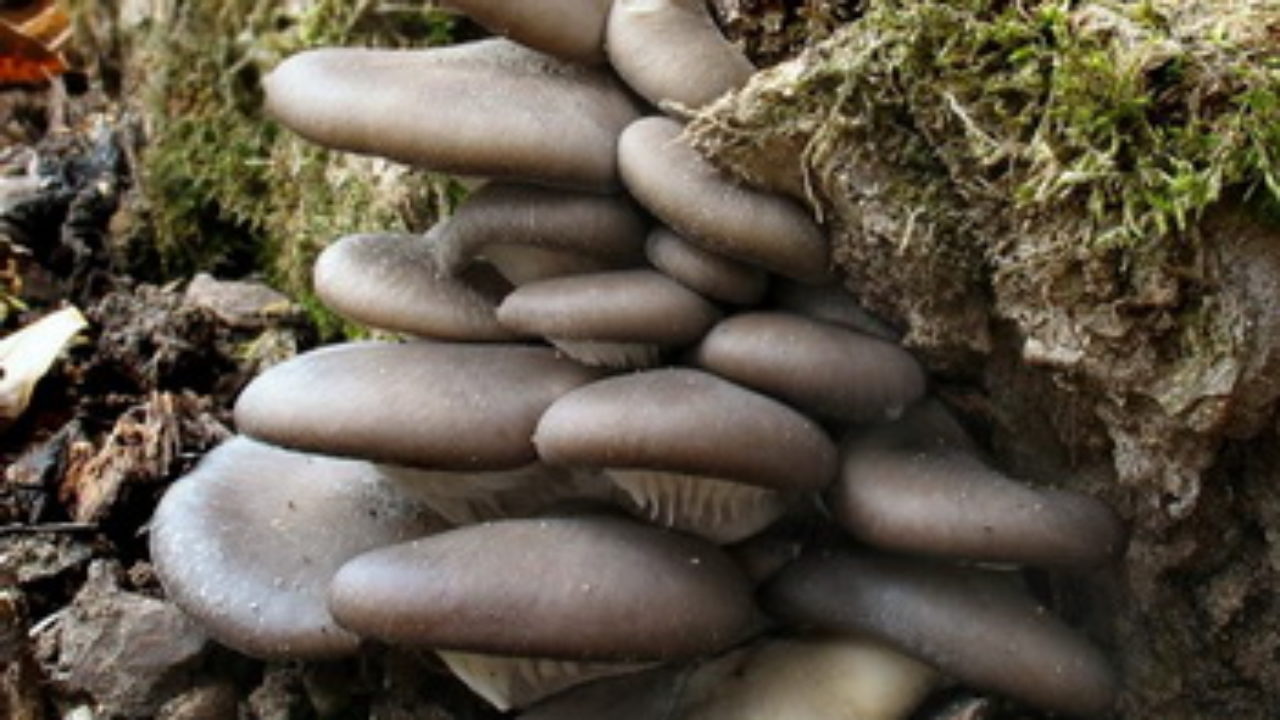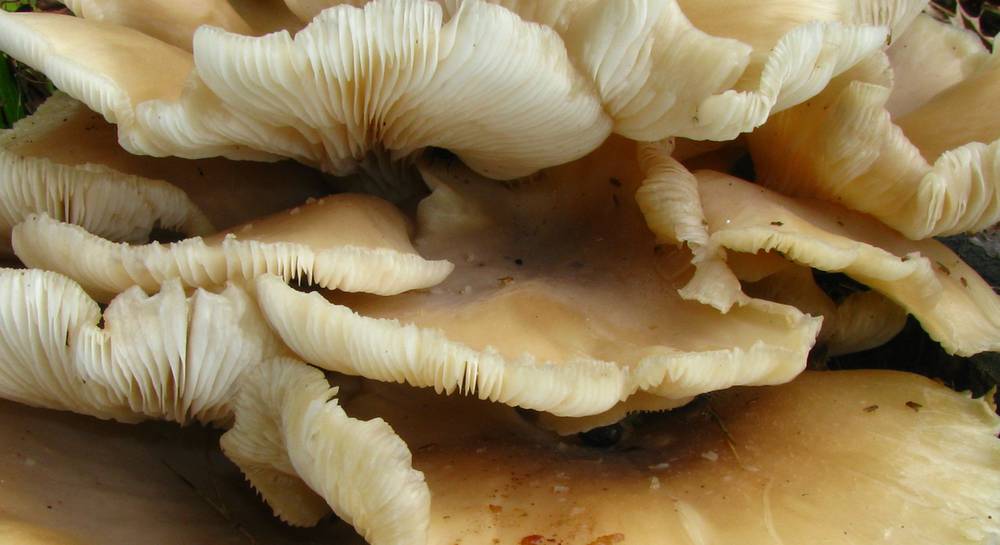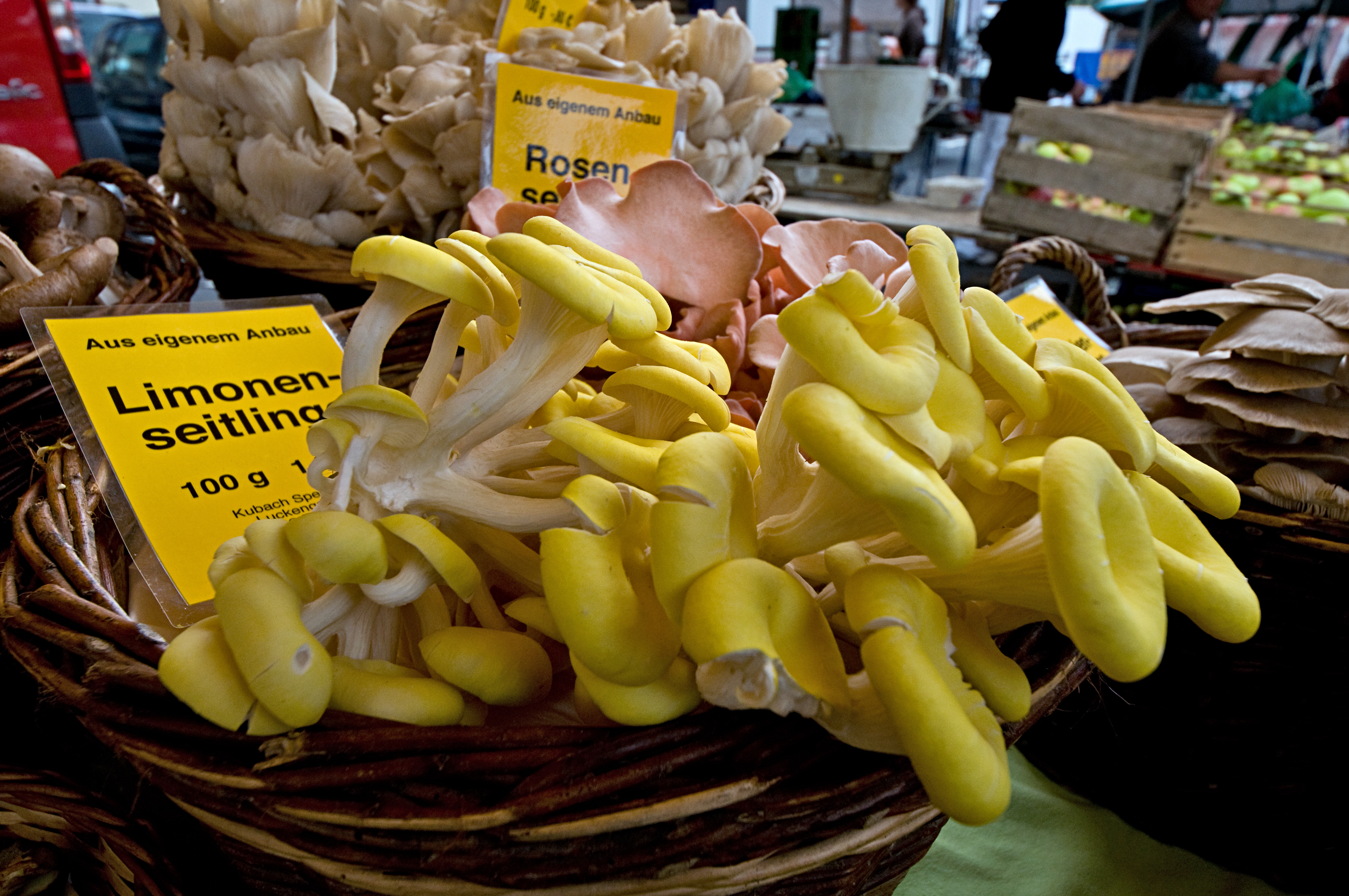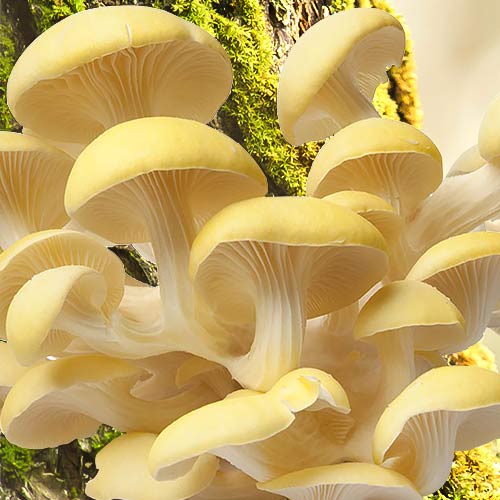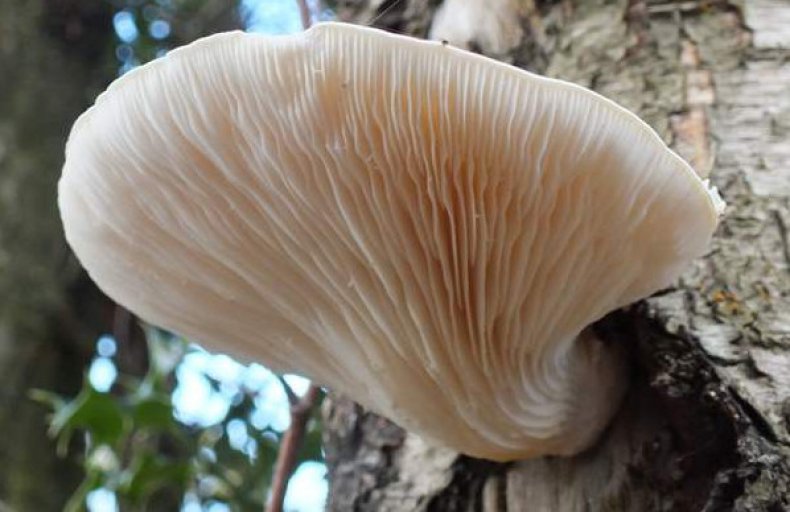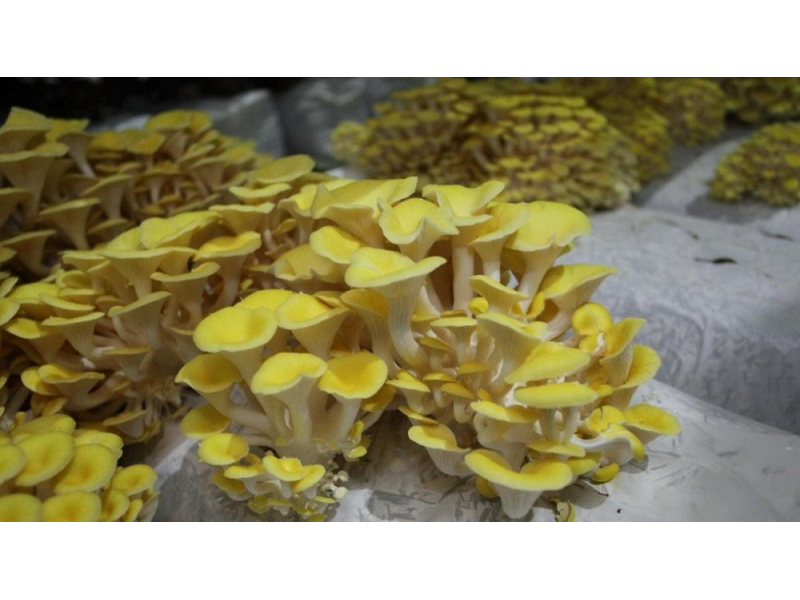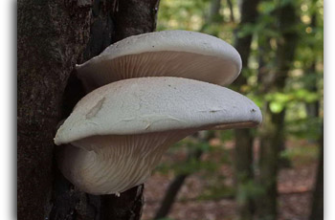Growing at home and in the country
But not everyone loves the forest "quiet hunt", and oyster mushrooms are not widespread everywhere. In this case, it can be grown at home. This is a very simple process that almost always leads to success.
For growing you will need:
- mycelium (mycelium);
- substrate on which the mushroom will grow;
- landing room.
Mycelium can be bought, preferably in a trusted place, making sure that all storage conditions are correctly followed. Do not keep it in the freezer. The optimum storage temperature in the refrigerator is 4 degrees. The mycelium should be orange with yellow inclusions, without green, black or brown spots. Having bought the mycelium of the desired strain of the mushroom, you need to let it cool down and put the bags in the refrigerator separately.
Before laying, the mycelium is crushed in a closed bag and its temperature is equalized with the temperature of the substrate. Their difference will negatively affect the quality of the mycelium.
The substrate can be straw, corn trunks, seed husks. It must be thoroughly treated with water or steam to provide moisture and create airtightness. The material must be crushed and allowed to drain off excess water. This will prevent mold and rot formation.
The room for growing oyster mushrooms should be separate, preferably a basement.
Growing technology

- Substrate processing.
The material is loaded into the tank and boiled for an hour and a half. The water is drained, put under pressure to cool to a temperature of 25 degrees.
- Mycelium bookmark.
In a tightly closed sterile room, wearing gloves, the mycelium is poured onto the disinfected surface of the table and mixed with the substrate material. The percentage of mycelium content in the composition should not exceed 5 percent. The finished mixture is tamped into small bags and half-centimeter cuts are made with a clean knife. Mushrooms will sprout through them.
- Incubation period.
This time until the beginning of fruiting is from 18 to 24 days. The bags are stored with free air access and a temperature of 25 degrees. Every day they carry out wet cleaning with a disinfectant. The room is not ventilated.
- Fruiting.
The first fruiting occurs within a month and a half. During this period, watering is allowed
It is important not to overmoisten! You can sprinkle mushrooms with water 1-2 times a day. The room needs to be ventilated
- Second harvest wave.
After harvesting the first crop, you must cut off all the legs and check the blocks for mold. The infected are removed from the room, they can be used as fertilizer.
With the correct content, mushrooms bear fruit up to six months, but the largest amount of harvest will fall on the second wave.
It is beneficial to grow golden oyster mushrooms at home: from 1 kilogram of mycelium, you can get up to 3 kilograms of fruit.
If you are only fond of picking mushrooms, it is important to know about the false counterparts of the ilmak
Oyster mushrooms (mushrooms) - description, characteristics, photo
Oyster mushrooms belong to mushrooms, in which the fruiting body consists of a cap, smoothly turning into a leg. The hat is solid, slightly thinning towards the edges. Its shape is round or oval-elongated, resembling a shell. The diameter of the cap varies from 5 to 17 cm, although there are mushrooms in which the size of the cap reaches 30 cm. Young oyster mushrooms have a smooth glossy surface of the cap, slightly convex, with edges slightly tucked inward. However, as they age, they unfold, and the cap itself flattens.

Photo Credit: Rob Hille, CC BY-SA 3.0
Depending on the species, the color of oyster mushrooms can be whitish, gray, brownish, lemon-yellow, brown-olive, ash-purple and even gray-lilac with shades of pink or orange.
Hymenophore with rather rare and wide plates of whitish, yellow or gray color, deeply descending to the pedicle.The white plates of a young mushroom turn gray or yellow with age.

Photo Credit: Rob Hille, CC BY-SA 3.0
The tubular stem tapers towards the base, usually located eccentrically in relation to the cap. Its dimensions reach a maximum of 50 mm in length and 30 mm in thickness.
Legs of oyster mushrooms are white, yellowish or slightly grayish.

Photo by: Qwert1234, CC0
The fruit body of a young mushroom has a firm and juicy pulp, which becomes fibrous, dry and tough as it ages.
Oyster mushroom spore powder has a white, cream or pinkish color, depending on the type of mushroom.
Oyster mushroom varieties, descriptions of varieties
What do oyster mushrooms look like? The color of the oyster mushroom cap can be yellow, grayish, purple, white, even pink. All young mushrooms of this species have predominantly white juicy flesh, if it is young. Older specimens have a stiffer, fibrous consistency. At home, they can grow and bear fruit all year round. The main thing here is to competently maintain the required level of humidity, lighting, and air temperature. Let's look at the most popular types of oyster mushrooms, which are popular with home-based mushroom pickers.
Oyster mushroom
This is one of the most popular, valuable species due to its excellent taste. The hat can be slightly lilac or brown. This variety feels comfortable when grown at home, and with the proper approach to business, it pleases with a harvest all year round.
Oyster, photo
Oyster mushroom
It has a cone-shaped hat, which is why it bears that name. In artificial conditions, it is grown on stumps, mainly elm. The color of the cap ranges from light brown (sandy) to dark brown. Has firm pulp, pleasant, albeit slightly specific aroma.

Pink oyster mushroom
Pink oyster mushroom has another name - Pink Flamingo. It is a beautiful, fast-growing mushroom with wavy edges of the cap, delicate pink color. This variety is thermophilic and requires an individual temperature approach (from + 16 ° C to + 30 ° C at different stages). Begins to bear fruit already 10 days after sowing the mycelium.
 Pink or Pink flamingos, photo
Pink or Pink flamingos, photo
Lemon oyster mushroom
There is another name: Ilmovik. The mushroom has a bright conical cap. This variety is distinguished by its unpretentiousness to growing conditions, it is grown both on a substrate and on stumps. It is characterized by the closeness of fruiting bodies, graceful elongated legs. The diameter of the cap varies from 5 to 10 cm.

Steppe oyster mushroom
Steppe oyster mushroom (eringi) is also called Royal. This is the most delicious variety of oyster mushrooms, it has a fleshy dense pulp, a massive funnel-shaped leg. The mushroom cap (5-10 cm in diameter) changes. While the mushroom is growing: at first it is convex, then it becomes flat, and by the time of harvesting it is already concave. This species is grown in special large jars or cans (photo below).

Oyster mushroom
Common - the most popular variety, is grown on stumps or on various substrates. Yields a harvest from summer - until the very frost. Has a grayish yellow or brown cap.
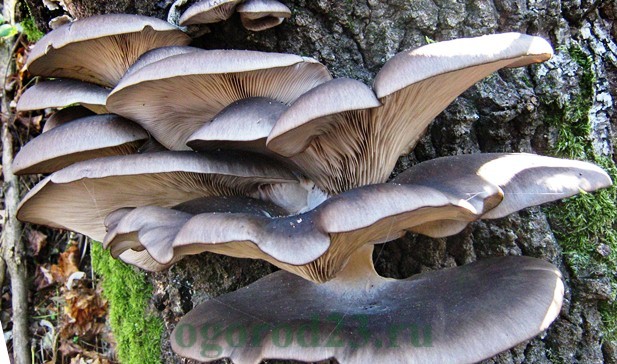
Florida oyster mushroom
It is a light beige or grayish-white mushroom with a semicircular, slightly funnel-shaped cap (10-20 cm in diameter). Requires higher temperatures during the growing and fruiting stages.
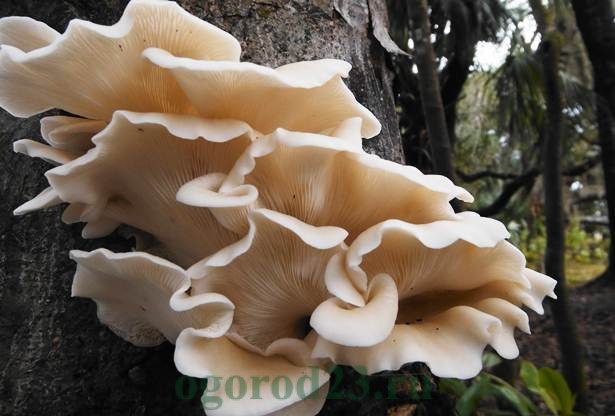
Pulmonary oyster mushroom
This species is eaten or processed only when young, as "old" mature mushrooms are characterized by increased rigidity. The cap of the mushroom has a tongue-like shape with slightly cracked edges, the color is white or brownish-cream. Fruiting from spring to the first cold weather.

Oyster mushroom late
A mushroom with an exquisite, pronounced taste. It can be brown, gray or brown in color. It has an ear-shaped cap that can reach large sizes (up to 25 cm in diameter), young mushrooms are darker in color, mature ones are lighter in color. It is grown on stumps or chocks (oak, poplar, aspen), as well as on substrates (straw, sunflower).
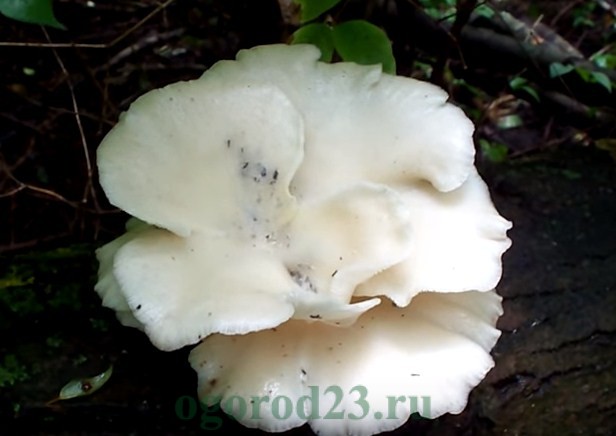
White Elf
A very tasty dietary grade. Has an elongated solid leg. The caps of this mushroom are white with slightly curly edges. The surface of the cap may be scaly. It is grown both on chocks or stumps, as well as on substrate blocks.

The above varieties of oyster mushrooms feel great when grown artificially. With proper care, they bear fruit abundantly. It is also worth mentioning hybrids, which are distinguished by high yields and unpretentiousness. The hybrids most preferred by mushroom pickers are: Dune NK-35, R-77, R-20, No. 420, No. 107.
Remember to unpack mycelium bags only with gloves. The material should be purchased from trusted sellers, the mycelium itself should be without black or green spots.
All of the above types of oyster mushrooms are adapted for growing at home.
The numerous advantages of some varieties of mushrooms contributed to the active development of their industrial cultivation.
Although initially attention was paid to truffles, today oyster mushrooms are also very popular. The reason for such popularity lies in the taste of this mushroom, which is not inferior to champignon
Oyster mushroom varieties are numerous and unpretentious, and their cultivation will require much less attention and care.
Beneficial features
Variety of varieties
Hybrids
Small Tips
Growing at home and in the country
There are 2 ways to grow mushrooms. The first one implies the use of natural material - tree trunks. The second is more common, and it consists in growing oyster mushrooms on the basis of a substrate that is placed in plastic bags.
The logs are used outdoors, and the bags are placed in the basement, greenhouse. A deep and spacious cellar is considered the best place. It is recommended to maintain the temperature and humidity conditions in it.
Useful materials for growing Oyster mushrooms in bags can be divided into two types. The first is the cultivation of mycelium, and the second is the production of fruit chalk.
To feed mushrooms in bags, they usually use resources such as:
- sawdust;
- wheat or barley straw;
- sunflower seed husk;
- shredded corn cobs;
- buckwheat husks, etc.
The main thing is that the substrate is sterile. To do this, you need to disinfect the room and the substrate. To carry out this procedure, you will need specialized antifungal drugs or bleach, close the cellar for two days, and then ventilate it.
It is also necessary to disinfect the plastic bag. The best solution for this disinfection will be potassium permanganate or bleach, and it is done a few days before filling with mycelium.
The bag should be filled in layers - a layer of substrate by 5 cm, then 5 mm of mycelium. The bag starts with the first layer of the substrate and ends with the last, then the neck is tied and holes are cut, 1 cm in size.
The incubation period lasts twenty days. This mushroom growth process is visible through the bag.
It is during this period that the lighting is turned on, which lasts eight hours daily, since this is the optimal daylight hours for mushrooms. We must not forget about spraying parts of oyster mushrooms, which are already visible over the bags. This must be done from a spray bottle, while the water temperature should be 20 - 25 degrees. It is necessary to ventilate the room daily.
After seven to ten days, fruiting bodies appear, their growth lasts about five days. The first crop is harvested within a month after the bag was formed. Mushroom picking should be done carefully; it is necessary to cut it off at the base of the leg. It is necessary to use a sharp knife so as not to damage the mycelium. The next crop is recommended to be harvested in 20-30 days. Over time, the nutritional and beneficial properties of the substrate decrease, after which, the material that has served its life can be used as fertilizer for the garden.
How to collect
Oyster mushroom grows on aspen, poplar, beech, less often on other species in coniferous and deciduous forests.She chooses dead and diseased wood, rotten stumps and fallen branches. Mushrooms are found on the banks of the Desna River, in Ukraine. This type of oyster mushroom is widespread in countries with a temperate climate.
Sometimes lovers of quiet hunting stumble upon trees that are abundantly covered with glaciers. Moreover, some specimens grow so high that it is almost impossible to get them. Mushrooms are cut with a knife directly from the tree by the whole family
This must be done carefully so as not to damage the mycelium.
It is advised to look around the whole clearing as a whole. Lumps often grow in colonies, spreading spores to other trees. Do not be afraid of wormy specimens. Oyster mushroom pulp contains nematoxin, which paralyzes them.
The harvest peak occurs in the first two months of autumn. If weather conditions permit, the mushroom appears in May.
Glyva is similar to its edible counterparts:
- Autumn oyster mushroom. There is a gelatinous layer inside her cap.
- Oyster mushroom horn-shaped. It has a more fragile build and a light cap with an elongated stem.
- Oyster mushroom is whitish. It has a light color and fragile flesh.
The mushroom has no poisonous counterparts.
Harm to the body
New Zealand does not allow the import or export of oyster mushrooms. In this state, it is considered a parasitic fungus that has a negative effect on native plants. However, in cooking, the inhabitants of the country actively use oyster mushroom.
Although considered safe, these mushrooms can sometimes cause unpleasant symptoms. It's all about individual intolerance. Oyster mushroom abuse can lead to gastrointestinal upset. Experts do not recommend eating them more than twice a week. There are other tips for using them:
It is important to know where the mushrooms for food were collected.
They pose a certain danger to girls in position, people of advanced age.
The product is cooked before cooking.
Do not get carried away with oyster mushroom foods for children and people with kidney and liver diseases.
Do not eat the product raw.
With an exacerbation of chronic diseases, it is worth consulting with a doctor about eating mushrooms.
Lemon oyster mushroom

Ilmak
Lemon oyster mushroom (Pleurotus citrinopileatus) is a cap mushroom from the Ryadovkov family, belongs to the Pleurotus genus (Pleurotus, Oyster mushroom).
External description
Lemon oyster mushroom (Pleurotus citrinopileatus) is a variety of decorative and edible mushrooms, the fruiting body of which consists of a stem and a cap. It grows in groups, and individual specimens grow together to form a beautiful lemon-colored mushroom cluster.
The mushroom pulp is white and has a flour smell. In young specimens, it is soft and tender, and in ripe mushrooms it becomes rough.
The stem of the mushroom is white (yellow in some specimens), comes from the central part of the cap. In mature mushrooms, it becomes lateral.
The diameter of the cap is 3-6 cm, but in some specimens it can reach 10 cm. In young mushrooms, the cap is thyroid, in mature fruiting bodies a large depression appears on it, and a little later the cap becomes funnel-shaped, and its edges are lobed. The bright lemon color of the cap of overripe, old mushrooms fades and becomes whitish.
The lamellar hymenophore consists of frequent and narrow plates, the width of which is 3-4 cm. They are slightly pinkish in color, descending to the pedicle in the form of lines. The spore powder is white in color, but in many specimens it has a pink-purple hue.
Season and habitat of the mushroom
Lemon oyster mushroom (Pleurotus citrinopileatus) grows in the southern part of Primorsky Krai, in mixed (with coniferous and broad-leaved trees) forests, on living or dead elms. This mushroom also develops well on elm deadwood, and in the northern regions and the middle vegetation zone it is also found on the trunks of birches. Lemon oyster mushrooms are widespread in the southern parts of the Far East; they are well known to the local population there and are used by them as edible mushrooms.Begins to bear fruit in May and ends in October.
Edibility
Lemon oyster mushroom (Pleurotus citrinopileatus) is an edible mushroom. Possesses good taste, it is used salted, boiled, fried and pickled. Lemon oyster can be dried. However, in ripe fruit bodies, only the cap is suitable for eating, since the stem of the fruit body becomes fibrous and rough. In some specimens, a part of the cap above the leg is also endowed with such qualities, so it also has to be cut out before cooking the mushrooms for food. Grown in artificial conditions for the purpose of implementation.
Other information about the mushroom
This oyster mushroom was named lemon yellow for its characteristic cap color, similar to the color of a ripe lemon. The mushroom retains its bright yellow color throughout its growth. Lemon oyster mushroom substrate mycelium is resistant to cold and frost. The mushroom itself is thermophilic, has a moderate taste properties, and becomes a real decoration for the garden.
Mushroom photo Lemon oyster mushroom
from questions in recognition:
Description
Lat. Pleurotus citrinopileatus - Golden pleurotus. Other names: Lemon oyster mushroom, Yellow oyster mushroom, Golden oyster mushroom, elmak, Golden Pleurotus, elmovik. Fruiting bodies are located on trees without much regularity in the amount of up to 30 pieces in the form of compact aggregates. Alone, they are very rare. Oyster mushrooms grow on dry trunks and stumps of the Far Eastern elm. Hence the name - Ilmovik.
Hat
In mature oyster mushrooms, the cap is almost white, irregularly funnel-shaped with a lobed edge. In a young mushroom, it is lemon-yellow, flat, with a depression in the middle. The diameter can vary from 5 to 30 cm. The plates are white or white-pink, can run down to the stem, are arranged evenly and relatively tightly.
Pulp
The pulp is soft and fleshy. The younger the mushroom, the juicier it is. When passing from the cap to the stem, the flesh coarsens. Has a white color, the smell is similar to flour.
Leg
The leg can be up to eight centimeters long and three centimeters wide. It is located more often eccentrically, cream-colored. In some elmaks, the leg is weak, in others it is completely absent. This is due to the adaptation of the fungus to the environment.
We now know what an oyster mushroom looks like. Where can the mushroom picker look for her?
Description
Oyster mushroom (Pleurotus Pulmonarius) belongs to the Oyster mushroom family, genus Oyster mushrooms. Also, this mushroom has other names, such as:
- Spring oyster mushroom;
- Beech oyster mushroom;
- Oyster mushroom is whitish;
- Pleurotus is whitish.
The mushroom is considered edible and healthy.
Hat
The hat is of medium size, its diameter is from 4 to 8 cm, but sometimes there are representatives of this species with a cap and up to 16 cm.The color of the skin of the cap is grayish-white or cream, sometimes it is light brown, darker at the point of attachment of the leg. In the process of growth, the hue changes to yellowish. The edges of the cap are thin and curved upward, more like an ear or a fan in shape.
Hymenophore
The plates of the hymenophore are relatively rare, dense, and descend along the pedicle, have a white tint, with age they begin to turn yellow or become creamy. Sometimes this color is found in young individuals.
Pulp
The flesh of the mushroom is dense, white-gray and has a pleasant smell and taste. The flesh on the stem is tough, in adult mushrooms it is more rigid than in young ones.
Leg
The stem of the mushroom is short, has a cylindrical shape without a cavity, mostly lateral, but can also be located in the center of the cap. The length reaches 4 cm, the diameter is from 6 to 15 mm. The surface of the peduncle is off-white, and the lower part is covered with hairs.
How to cook
The mushroom is suitable for any kind of culinary treatment. It can be pickled, dried and salted. Young mushrooms are soft and tender, unlike adult specimens, which become tough. Mushrooms with a “headdress” diameter of no more than 15 centimeters are suitable for food. You can determine the age of the mushroom by the color of the cap: the lighter it is, the older the oyster mushroom.
There are many recipes with glips, among them:
- warm salad with kohlrabi cabbage and oyster mushrooms;
- stewed mushrooms with sour cream;
- hot plate in English.
Mushrooms are best combined with meat and vegetables; it is better not to add them to fish. Oyster mushroom is especially tasty when fried, as an additional dish to a hot dish.
Oyster mushroom meatballs
Housewives who want to surprise their family with a delicious dinner should cook oyster mushroom meatballs. This will require the following components:
- 300 grams of mushrooms;
- three potatoes;
- two eggs;
- a third of a glass of milk;
- breadcrumbs (two large spoons);
- onion;
- pepper and salt.
Step by step recipe:
- Boil the potatoes until half cooked.
- Rusks are mixed with milk.
- Mushrooms are boiled and chopped in a meat grinder along with potatoes. You should get a homogeneous minced meat.
- Beat eggs with a whisk in a plate.
- Add to them crackers with milk, pepper and salt.
- Mix everything into one mass and form meatballs.
- Fry them in a pan with vegetable oil.
The dish is served on the table with mashed potatoes and vegetable salad.
Oyster mushrooms are revered all over the world. They are unpretentious in cultivation and preparation. Therefore, you should not pass by, meeting their family on an old rotten tree stump.
Preparation
You learned all about oyster mushrooms and you probably wanted to try them. Ilmaki can be boiled, fried, preserved for the winter and frozen.
How to properly cook mushrooms, we will consider further.
Cleaning
First of all, you need to make sure that there are no green or black spots on the mushroom. The color must be uniform. Basic cleaning rules:
Basic cleaning rules:
- start it immediately after collection / purchase;
- you do not need to wash the mushrooms before cleaning;
- use a knife for the leg, and a brush for the hat;
- rinse under running water after cutting off unnecessary elements;
- after cleaning, put the mushrooms in salted water - this way they will not turn black.
To process oyster mushrooms, begin with cutting off dark spots, if any. Then remove the lower part of the leg and all the irregularities in the edges of the cap.
Cooking
Chop the mushrooms and cover with cold water. There should not be a lot of it, since the ilmak secretes juice during the cooking process. Season with salt and spices to taste. Cook for up to 20 minutes after boiling water, over medium heat. Whole large specimens can be cooked longer - up to half an hour. Then put in a colander and let the water drain, shaking. These mushrooms can be eaten or frozen.
Freeze for the winter
Boiled ilmoviks should be allowed to dry and transferred to plastic wrap. Send in this form in the freezer for 3-4 hours. Then take it out, fill it in bags and return it to the freezer.
You can also freeze fresh ilmoviks: then, after washing and drying, they are placed in a chamber for 2 hours at a lower temperature in it, then laid out in bags.
Pickling
A simple recipe will help you quickly pickle oyster mushrooms at home. For 1 liter of marinade you will need:
- about one teaspoon of sugar;
- half a teaspoon of salt;
- 3-4 peas of pepper;
- Bay leaf;
- a tablespoon of vinegar.
Boil water, add spices and put mushrooms. Simmer on low heat for 20-30 minutes. Cool ready-made elmaki in the marinade and transfer to jars. After cooling completely, place in the refrigerator.
Frying
 You do not need to boil oyster mushrooms before frying. They are laid out in a preheated pan with onions and fried until golden brown. After that they are stewed under a lid on low heat, allowing the taste to unfold to the fullest. Simmer for no more than 20 minutes so that they do not become hard. Various vegetables can be added to the mushrooms to taste.
You do not need to boil oyster mushrooms before frying. They are laid out in a preheated pan with onions and fried until golden brown. After that they are stewed under a lid on low heat, allowing the taste to unfold to the fullest. Simmer for no more than 20 minutes so that they do not become hard. Various vegetables can be added to the mushrooms to taste.
Salting
Salting mushrooms for the winter is very popular, and for good reason: after all, those who have tried them in canned form at least once will hardly remain indifferent!
A very simple and quick recipe for making 0.5 kg oyster mushrooms. Pour 2 liters of water into a saucepan, add 50 grams of salt and place the peeled ilmoviks there. Cook for 5-7 minutes, transfer to a colander. While the water flows down and the mushrooms cool down, prepare the brine. For him you need:
- 200-300 grams of water;
- one tablespoon of salt;
- 4 bay leaves;
- 4 peppercorns;
- 4 black currant leaves.
Bring the water to a boil and add the rest of the ingredients. Cook for another 5 minutes, stirring. Filter the brine from coarse spices and boil again. Put oyster mushrooms tightly in sterile jars and fill with cooled brine. Store jars in a cool place. You can taste it in a week!
Canning with lemon juice for the winter
Above, we have already considered the method of preserving oyster mushrooms. An indispensable component of any salting is vinegar. When preserving mushrooms with lemon juice, the proportion of vinegar is significantly reduced, which makes the dish even more useful. Chopped garlic and dry dill can be added to the brine with juice.
Tincture recipe
It is used for the prevention of neoplasms (tumors) and general strengthening of the immune system. The fruiting bodies of the fungus can be infused with wine or vodka.
1. Fifty grams of chopped mushrooms are poured into 0.5 liters of wine and kept for a week. Consume 1 tablespoon 3 times a day. It is advisable to take a tincture of wine in case of cardiovascular diseases.
2. Put 300 grams of mushrooms in 0.5 liters of vodka. Infuse the mixture for 2 weeks, take a teaspoon 2 times a day. This traditional medicine has a proven antitumor effect. It is also used as an adjunct treatment for mastopathy. To prevent colds and strengthen immunity, the same 500 grams of vodka and 100 grams of oyster mushrooms are used. Insist and take a teaspoon three times a day during seasonal outbreaks of infectious diseases.

